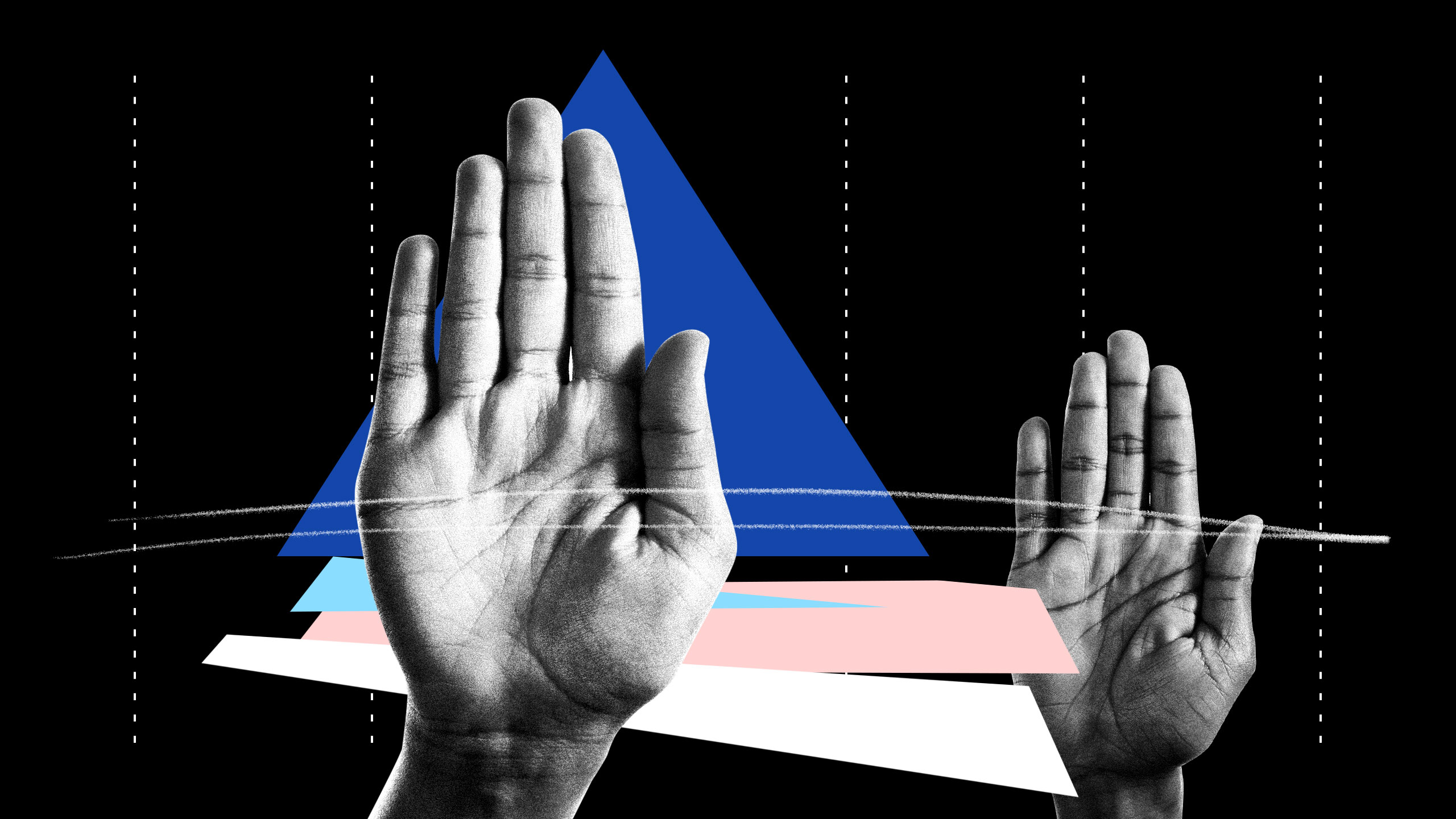Editor’s note: This story discusses sexual violence and harassment in detail.
I was sexually assaulted at least three times before I left high school. I say “at least” because the violence of those years was so routine and constant that I have a hard time figuring out what matters, which assaults should make the Greatest Hits tape. There was an incident with three boys at a local swimming pool that definitely counted; there was an attempted abduction by my youth group counsellor and a second cousin who found me alone in the woods. There are incidents that skate the border without quite making it onto the list: the boy who used to stand over me at lunch whispering the vile things he would do to me, or the female friend who used to pressure me into sex by threatening to tell her friends I was queer.
There was a lot, and it blurs together eventually: hands where they shouldn’t be, secrets I had to keep. When my parents pulled me out of school, I was dissociating, breaking down in tears midday, cutting myself in class. My favourite teachers called my mother to tell her I was a suicide risk. I was part way through my sophomore year; 14, maybe 15 years old.
When I identified primarily as a feminist—a cis feminist, that is; a white, presumed-straight woman—I had a simple analysis for all this. Rape is the tool used to keep women in line. I was raped ergo I was a woman. Here endeth the lesson.
Yet these assaults happened a lot. They didn’t happen because of any one person, but because a whole community decided I was unacceptable. Nor did they happen because I was feminine; quite the opposite. My second cousin told me he was trying to prove I wasn’t a boy under my clothes. My other attackers seemed disgusted or angry that I didn’t look or behave the way “girls” should. It was not until midlife that I could bear to think about this or remember it long enough to draw any conclusions. But when I really heard the message in all those memories—you are a boy; this is your punishment for acting like a boy; this would not happen if you would stop being a boy—everything had to change.
Most of the available data on sexual violence does not include trans people. The categories are implicitly cissexist, classifying every victim as “male” or “female” with no room for elaboration. Other studies remain vague in their conclusions: Statistics Canada, for instance, tells us that trans people are “more likely to have experienced violence since age 15, and also more likely to experience inappropriate behaviours in public, online and at work than cisgender Canadians,” but does not tell us how much more likely or which forms of violence are most common. However, the data we do have all points to one conclusion: trans people are being sexually assaulted at staggering rates. According to the 2015 National Trans Survey, conducted by the American non-profit National Center for Transgender Equality (NCTE), almost half of transgender people have been sexually assaulted in their lifetimes. Among transfeminine people or trans people of colour, those numbers go up.
Sexual violence is also uniquely gruelling for trans people because it opens them up to further violence. Brussels-based Cianán Russell, of the Trans Survivors’ Network, says that according to his organization’s most recent research, “only about one in 10 [trans] people go to police or formalized reporting, which as I understand it is a lower number than cis women. And among those people, about a quarter experienced some kind of violence at the hands of police while reporting.”
It’s not just the police. D. Ojeda, a Washington, D.C.-based policy advocate at the NCTE, says that trans abuse survivors who flee to shelters are often attacked once they arrive, an experience that can include additional sexual assaults. Multiple survivors that I spoke to for this piece mentioned that their therapists used their assaults to try to discredit their gender identity; my friend Sebastian (whose name has been changed to protect his privacy and safety) told me that he didn’t mention his rape to his therapist because “[she] very much viewed me being a domestic abuse survivor as a sort of proof of my femininity… I didn’t want to seek support if it meant being misgendered.”
“The more legislative and structural discrimination there is against trans people, the more assault there will be.”
This is where a lot of trans survivors end up: unwilling to seek support because they cannot believe it will be offered. That suspicion is warranted, and conditions are likely to get worse in the near future: “[The NCTE’s data] is from 2015,” Ojeda says. “We’re currently about to start our survey again. I would not be surprised if the numbers are higher.”
Ojeda cited two factors that would likely drive up rates of sexual violence. First, the overtly anti-trans policies of the Donald Trump administration (which, under President Joe Biden, have transmigrated into an onslaught of state-level legislation aimed at restricting trans people’s rights). Trans people aren’t just vulnerable to sexual assault because we’re hated; we’re vulnerable because discrimination places a disproportionate number of trans folks in situations—like homelessness or survival sex work—where sexual assault is far more common. The more legislative and structural discrimination there is against trans people, the more assault there will be.
Then, there is the other problem: what Ojeda calls “this perpetuated myth that trans people are inherently perpetrators.” To the extent that the general public ever hears about trans people in connection to sexual violence, they hear us portrayed as predators, not as victims. Anti-trans activists have persistently, baselessly demonized trans women as ravening sexual predators, and have been able to get remarkable leverage in recent years by posing as survivor advocates who want to “protect” cis women and girls.
“There’s definitely biological essentialism behind the notion that men are inherently ‘dangerous’ and ‘sex-driven,’ while women are ‘safe,’ ‘vulnerable’ and lacking sexual desires of their own,” says Julia Serano, California-based author of the transfeminist classic Whipping Girl and several other books on the intersections of trans politics and feminism.
Serano is the leading theorist of transmisogyny, the specific interlocking set of sexist oppressions faced by trans women. She notes that the anti-trans position on sexual violence is based on a deeply regressive idea of what “men” and “women” are—and those stereotypes, in turn, obscure the real power dynamics of sexual assault.
“It’s true that the vast majority of sexual violence is perpetrated by men,” Serano says, “[but] I (and most feminists I know) would argue that this is largely the result of social factors, such as patriarchy, rape culture, toxic masculinity or whatever your preferred term is for the belief that ‘real men’ are supposed to dominate other people.”
Those social factors are key. There is a long history of minorities being demonized as sexual threats—Black men accused of preying on white women, gays accused of “recruiting” kids—and that violence, Serano says, is typically propaganda by the dominant culture, obscuring the far greater violence being done against the vilified group. Just as the myth of the Black rapist historically obscured the high rates of sexual assault being committed by white men against Black women, trans women are the single most at-risk group for sexual assault according to some studies—and their attackers are, overwhelmingly, cis.
The most common feminist analysis of rape (which, for the record, I strongly agree with) is that it is a product of power. People with more power assault people with less, and are shielded from consequences by their higher status. For this reason, the great majority of sexual or intimate assaults (up to 90 percent of rapes and 97 percent of domestic abuse cases) are committed by cis men against cis women. But this doesn’t happen because of any inherent qualities one can ascribe to “manhood” or “womanhood”; it happens because cis heterosexual couples are our most common example of a relationship built around a power imbalance. The men have power that the women don’t, and they use it to bad ends.
“People with more power assault people with less, and are shielded from consequences by their higher status.”
Other relationships contain power imbalances that can be just as dangerous. A mother who sexually abuses her son is exploiting a power imbalance. So is a teacher who sexually assaults a student, a white cop who rapes a Black man or a cis woman who abuses her trans girlfriend. To really understand sexual violence, especially outside of heteronormative contexts, we have to stay attuned to the specific ways power operates in the communities being discussed.
Many of the survivors I spoke to for this piece mentioned that they suffered by being written out of mainstream narratives. Kaleb, a transmasculine person raped by their cis female partner, wasn’t willing to use the word “rape” for years. “It would have taken a different culture,” they told me. “It took believing that women can also be coercive controlling abusers, that they can believe that they ‘own’ someone else’s junk, that they are entitled to pleasure. Back in 2005, nobody talked about it that way.” Cianán Russell, who has been sexually assaulted by two cis gay men, told me that “the power dynamic that trans men have with cis men was a central component in what happened and how it was able to happen. In cis gay men’s spaces, many trans men navigate from a position of inferiority… [trans men] are frequently required to make adjustments to their boundaries that they otherwise wouldn’t want to make.”
If we don’t know how social power dynamics render trans people vulnerable, we can’t understand those stories—and if we can’t understand them, we won’t be able to prevent the next assault. Rape is about power, but power can take surprising forms, including the power to look like the kind of victim people want to believe.
I am still sorting through the junk drawer of my adolescent sexual trauma. I am pretty confident these things didn’t happen because I was a girl—I wasn’t one—but I’m not sure they happened because I was a boy, either. It seems like a stretch to attribute all my attackers some prescient knowledge of my gender, when I didn’t even know it myself.
What I was, though, was unassimilable. Something about me didn’t fit the shape of the world. My peers were scaring me straight, showing me what and who I could safely be in their presence; they were assigning me womanhood by imprinting brutally misogynist ideas about women’s role onto my body. I was a gingerbread man being cut free of the dough surrounding him. Pieces of me were severed and stripped away to make me look more human.
When we insist on making sexual violence fit the gendered schematics we are most comfortable with, we replicate that violence. We exclude suffering people from our idea of justice; we become agents of their suffering. The unassimilable rape story—the data point that doesn’t add up, the snag in the argument, the contradictory evidence you can’t quite resolve—is not a problem, but an invitation to understand the complexity of violence and power as they operate in the world. Every survivor’s story is an important story. Every story has the chance to teach us something new.
“[Trans survivors] can feel very lonely,” Ojeda told me. “We don’t want to erase the experience of [cis] women. We want to add to it. We want to add what experiences look like for other marginalized communities. Solidarity is far more powerful than segregating our experiences the way we have.”


 Why you can trust Xtra
Why you can trust Xtra


